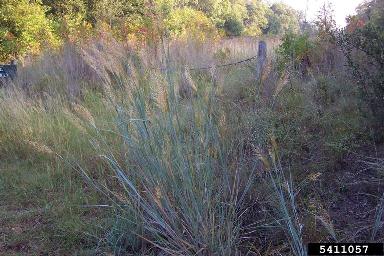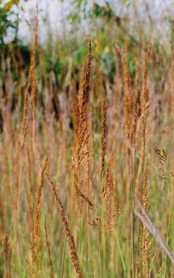A prairie can be an enjoyable addition to your acreage, as well as be a good habitat for wildlife. There are many different types of grasses and wildflowers to choose from. The plant of the month for September, Indiangrass, is a grass that would work very well in a prairie or as a focal point around your home.
Indiangrass, Sorghastrum nutans, is a native grass that grows in a bunch or clump. It is a fairly large grass species, growing up to 7 feet tall 4 feet across. People enjoy the amazing fall color of Indiangrass, according to Stock Seed Farms. The ¼" to 3/8" green leaves fade to orange in the fall and then turn reddish-tan in the winter and last throughout the winter. The flowers are in a panicle, a long strand of flowers, that is 4-8 inches long. The flowers are golden colored and they mature in August to September.
There are many different varieties of Indiangrass. A few varieties actually originated in Nebraska, including 'Oto', 'Holt', and 'Nebraska 54'. All three of the Nebraska varieties of Sorghastrum nutans would be great choices for your acreage, pasture, or landscape. There are also a couple of blue varieties including 'Sioux Blue' and a dwarf blue-leafed plant 'Bluebird,' which only grows up to 3-4 feet tall.
Indiangrass, like most grasses, thrives in full sun or very light shade. It can live in many different types of soils, including sandy soils, but prefers to live in soils with average moisture. According to Utah State University Extension, Sorghastrum nutans is found in Southern Utah where annual precipitation is 10 inches or less with occasional flooding. This grass also makes a great soil stabilizer in areas where the ground may wash away or on steep slopes.
Indiangrass is used most often in prairies, landscapes, or on steep slopes. It can be used in pastures and in wildlife habitat areas because it is a nutritious forage for wildlife and livestock. Utah State University suggested that Indiangrass not be over-grazed because the plant will not tolerate over-grazing. This is a great grass to use for many different areas on your acreage or in any landscape.
Sorghastrum nutans is a great grass species to use on an acreage, in a pasture, or in a landscape setting. Grasses make a beautiful fall focal point in all of these locations. As with any grass, the seeds can be planted in the spring or in the fall. In your yard, cut the plant back to the ground or mow it off in the late winter to remove the dead leaves and seed heads in preparation for spring growth.


